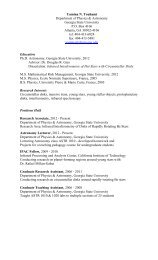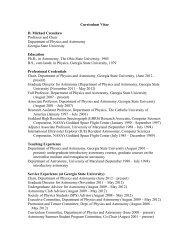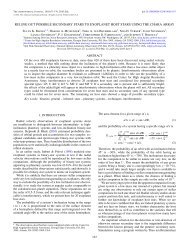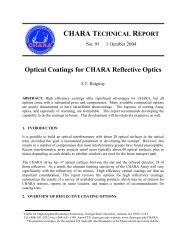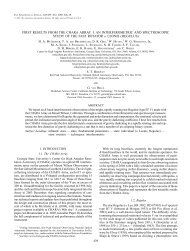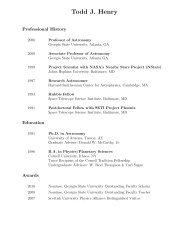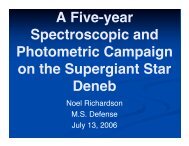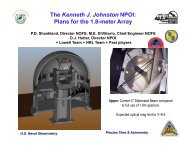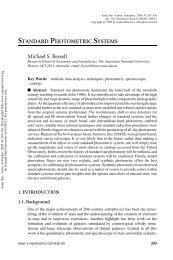Adaptive Optics Photometry and Astrometry of Binary Stars. II. A ...
Adaptive Optics Photometry and Astrometry of Binary Stars. II. A ...
Adaptive Optics Photometry and Astrometry of Binary Stars. II. A ...
Create successful ePaper yourself
Turn your PDF publications into a flip-book with our unique Google optimized e-Paper software.
550 ROBERTS, TURNER, & TEN BRUMMELAARVol. 133<strong>and</strong> H5 17 Aa-C. Shatskii (1998) determined that the Aa-C pairis a nonphysical optical binary. The central Aa pair is a double-linespectroscopic binary (Batten et al. 1978), <strong>and</strong> Hummell et al. (1995)measured the orbit with the Mark <strong>II</strong>I interferometer. The systemhas been observed 15 times by multiple speckle-interferometrygroups with no one detecting the companion we have detected,which is to be expected from the large dynamic range.From the I-b<strong>and</strong> differential magnitude, the companion wouldbe later than a K6 V star. If physical, the separation is such thatthe system would be hierarchal <strong>and</strong> stable. It could also be abackground star; additional measurements are needed either tomeasure the color or to measure orbital motion. As the possiblenew companion is quite close <strong>and</strong> has a high dynamic range, itcould be a speckle <strong>and</strong> a false detection. However, the companionlooks much like that in the observation <strong>of</strong> HD 23862 (seebelow), which is real.HD 23862 (WDS 03492+2408).—The system primary is thefamous star Pleione. It is a member <strong>of</strong> the Pleiades <strong>and</strong> hasseveral known companions. The HL 28 Aa-B, HL 28 Aa-C, HL28 Aa-D, <strong>and</strong> HL 28 Aa-E pairs all have separations over 1 0 .There is also the close CHR 125 Aa pair, which was discoveredby McAlister et al. (1989). Mason et al. (1993) presented a fewother measurements but also noted that it was undetected 8 times.It was also undetected by Balega et al. (1994). McAlister et al.(1989) said that the peaks <strong>of</strong> the autocorrelation are weak <strong>and</strong>indicative <strong>of</strong> a large dynamic range, which would only be detectedunder ideal seeing conditions. Pleione is a known variablestar (Goraya et al. 1990), so the failures could be due to the factthat the dynamic range between the primary <strong>and</strong> companionchanges <strong>and</strong> <strong>of</strong>ten exceeds the limit <strong>of</strong> speckle interferometry.We do see the CHR 125 Aa pair, but fitstars is unable to convergeon a solution because the AO PSF is quite odd due to poorperformance <strong>of</strong> the AO system. Even though we cannot use fitstars,we can create an estimate <strong>of</strong> the astrometry. The estimatedseparation <strong>of</strong> the system is 0.24 00 , which agrees with previous measurements.So we can say with confidence that we are detecting thecompanion <strong>and</strong> not a speckle. Follow-up observations are needed tomeasure the differential magnitude <strong>of</strong> the companion in severalepochs to see if it is a fixed value or variable.Pleione has also long been known to show radial velocity variations,<strong>and</strong> Luthardt & Menchenkova (1994) determined thatthe system has a period <strong>of</strong> 35 yr <strong>and</strong> concluded that this is the sameas the CHR 125 Aa companion. Katahira et al. (1996) disagreed<strong>and</strong> found a period <strong>of</strong> 218 days, <strong>and</strong> concluded that the system is atriple system. Spectroscopic analysis is complicated by the shells<strong>of</strong> gas that the star throws out periodically. Additional observationswith AO are needed, as it can help determine the orbit <strong>of</strong>CHR 125, which can be compared to the spectroscopic results.We also detect a previously unknown companion with a separation<strong>of</strong> 4.66 00 . The measured differential magnitude is 9:4 0:5. Since the separation is over 4 00 , it is probable that the imageis suffering from anisoplanatism, in which the PSF <strong>of</strong> the primary<strong>and</strong> the secondary are slightly different. Since fitstars assumesthat the PSFs are identical, this will cause an error in the results.We are not able to determine how much larger the errors are, butsome caution should be exercised when using these results. Theeffects <strong>of</strong> anisoplanatism on AO binary star observations are discussedin Roberts et al. (2005). It is hard to determine at whatseparation anisoplanatism is a significant effect since it dependson the degree <strong>of</strong> AO correction <strong>and</strong> on the atmospheric turbulenceat the time <strong>of</strong> the observations. As a rule <strong>of</strong> thumb we havechosen 4 00 as a break point based on experience.If the system is physically bound, this would be a main-sequenceM star or redder, which indicates that it is probably a backgroundstar. However, this determination is in considerable doubt because<strong>of</strong> the poor data quality, the variable nature <strong>of</strong> the primary, <strong>and</strong>the possible spectroscopic companion. These all corrupt the measurement<strong>of</strong> the differential magnitude. Further observations areneeded to see whether this new system component is gravitationallybound.HD 106625 (WDS 12158 1733, Crv).—A literature searchdid not turn up any prior indications that this is a binary star. Wehave detected a companion with a separation <strong>of</strong> 1:06 00 0:01 00<strong>and</strong> a I <strong>of</strong> 7:1 1:0. Based on the measured photometry, thecompanion would have a spectral type <strong>of</strong> K5YM5 V. Merrill(1922) did not resolve the binary with the Michelson interferometeron the 2.54 m Hooker telescope, nor did Brown et al.(1974) with the Narrabri Observatory intensity interferometer.Neither instrument would have detected a companion with themeasured differential magnitude. Again, we are unable to determineif this is a background star or a physical companion.HD 120198 (WDS 13466+5426, 84 UMa).—The system hasa known wide companion, LDS 2914, with a separation <strong>of</strong> 70 00(Mason et al. 2001). Abt & Snowden (1973) found a constantradial velocity, indicating that the system is not a spectroscopicbinary. The possible spectral type is later than an M8 V. This is avery late spectral type <strong>and</strong> suggests that the star is probably abackground star.HD 135742 (WDS 15170 0923, Lib).—We have detecteda companion with a separation <strong>of</strong> 2:09 00 0:01 00 <strong>and</strong> a I <strong>of</strong>8:8 0:5. McAlister et al. (1993) observed the system twice <strong>and</strong>did not resolve any companions, due to the high dynamic range.From the dynamic range, we estimate that the companion is laterthan a M2 V star. This increases the chance that this is a backgroundstar, but follow-up observations are needed.HD 174638 (WDS 18501+3322, Lyr).—This is the prototype<strong>of</strong> the Lyr class <strong>of</strong> eclipsing binaries. It is composed <strong>of</strong> apair <strong>of</strong> B stars, where one <strong>of</strong> the components is Roche lobe filling<strong>and</strong> donates mass to the other. The mass gainer is shrouded inan accretion disk, <strong>and</strong> there are numerous gas streams (Hubeny &Plavec 1991). The WDS also lists five companions, all with separationsgreater than 45 00 : STF 39 AB, BU 293 AC, BU 293 AD, BU293 AE, <strong>and</strong> BU 293 AF. The B <strong>and</strong> F components are physical,while the others are not (Abt et al. 1962; Abt & Levy 1976).We have detected a possible companion with a separation <strong>of</strong>0:54 00 0:02 00 <strong>and</strong> a differential magnitude <strong>of</strong> 4:53 0:20. Thedifferential magnitude suggests that the companion is a B2YB5 Vstar, but since the primary is actually the combination <strong>of</strong> two stars,one <strong>of</strong> which is shrouded in an accretion disk (Hubeny & Plavec1991), the determination <strong>of</strong> the new companion’s spectral type isgoing to be difficult even with additional filters. It is possible thatthe companion is a speckle in the AO system masquerading as astar, although it is farther out from the primary <strong>and</strong> brighter thanmost speckles. If the companion is physical, it would form ahierarchal system.Numerous observations with speckle interferometry have failedto show this companion (Bonneau et al. 1986; Miura et al. 1992,1993, 1995; Isobe et al. 1992), but speckle interferometry wouldnot be expected to see a companion with a I <strong>of</strong> 4:53 0:20. Thesystem has also been extensively studied with spectroscopy.Harmanec & Scholz (1993) reanalyzed 100 yr <strong>of</strong> radial velocitymeasurements. They detected possible slight variations <strong>of</strong> thesystematic velocity <strong>of</strong> the system, which may arise from the blendingeffects <strong>of</strong> the circumstellar environment <strong>and</strong> do not requirean unseen companion.HD 164906 (WDS 18044 2423).—A literature search turnedup no prior indications <strong>of</strong> this star being binary. We detected a possiblecompanion with a separation <strong>of</strong> 3.14 00 <strong>and</strong> a I <strong>of</strong> 8:04 0:37.



